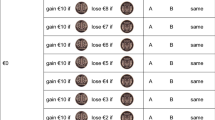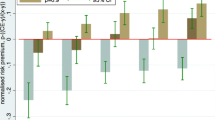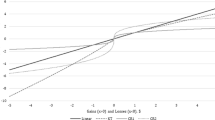Abstract
This paper provides an efficient method to measure utility under prospect theory. Our method minimizes both the number of elicitations required to measure utility and the cognitive burden for subjects, being based on the elicitation of certainty equivalents for two-outcome prospects. We applied our method in an experiment and were able to replicate the main findings on prospect theory, suggesting that our method measures what it is intended to. Our data confirmed empirically that risk seeking and concave utility can coincide under prospect theory. Utility did not depend on the probability used in the elicitation, which offers support for the validity of prospect theory.


Similar content being viewed by others
Notes
The idea of simultaneously estimating decision weights and utility was also recently used by Viscusi and Evans (2006).
References
Abdellaoui, Mohammed. (2000). “Parameter-Free Elicitation of Utility and Probability Weighting Functions,” Management Science 46, 1497–1512.
Abdellaoui, Mohammed, Aurélien Baillon, and Peter P. Wakker. (2007). “Combining Bayesian Beliefs and Willingness to Bet to Analyze Attitudes towards Uncertainty,” Working Paper, Erasmus University.
Abdellaoui, Mohammed, Carolina Barrios, and Peter P. Wakker. (2007). “Reconciling Introspective Utility with Revealed Preference: Experimental Arguments Based on Prospect Theory,” Journal of Econometrics 138, 356–378.
Abdellaoui, Mohammed, Han Bleichrodt, and Corina Paraschiv. (2007). “Measuring Loss Aversion under Prospect Theory: A Parameter-Free Approach,” Management Science 53, 1659–1674.
Andersen, Steffen, Glenn Harrison, Morten Lau, and E. Elisabet Rutström. (2007). “Behavioral Econometrics for Psychologists,” Journal of Economic Psychology (forthcoming).
Baucells, Manel and Antonio Villasis. (2006). “Stability of Risk Preferences and the Reflection Effect of Prospect Theory,” Working Paper, IESE.
Beattie, Jane, and Graham Loomes. (1997). “The Impact of Incentives upon Risky Choice Experiments,” Journal of Risk and Uncertainty 14, 155–168.
Benartzi, Shlomo, and Richard H. Thaler. (1995). “Myopic Loss Aversion and the Equity Premium Puzzle,” Quarterly Journal of Economics 110, 73–92.
Bleichrodt, Han, and Jose L. Pinto. (2000). “A Parameter-Free Elicitation of the Probability Weighting Function in Medical Decision Analysis,” Management Science 46, 1485–1496.
Bleichrodt, Han, Jose L. Pinto, and Peter P. Wakker. (2001). “Making Descriptive Use of Prospect Theory to Improve the Prescriptive Use of Expected Utility,” Management Science 47, 1498–1514.
Booij, Adam S. and Gijs van de Kuilen. (2007). “A Parameter-Free Analysis of the Utility of Money for the General Population under Prospect Theory,” Working Paper, University of Amsterdam.
Bostic, Raphael, R. J. Herrnstein, and R. Duncan Luce. (1990). “The Effect on the Preference Reversal of Using Choice Indifferences,” Journal of Economic Behavior and Organization 13, 193–212.
Camerer, Colin F., and Robin M. Hogarth. (1999). “The Effects of Financial Incentives in Experiments: A Review and Capital–Labor–Production Framework,” Journal of Risk and Uncertainty 19, 7–42.
Chateauneuf, Alain, and Michèle Cohen. (1994). “Risk Seeking with Diminishing Marginal Utility in a Non-Expected Utility Model,” Journal of Risk and Uncertainty 9, 77–91.
Cubitt, Robin, Chris Starmer, and Robert Sugden. (1998). “On the Validity of the Random Lottery Incentive System,” Experimental Economics 1, 115–131.
Diecidue, Enrico, and Wakker, Peter P. (2001). “On the Intuition of Rank-Dependent Utility,” Journal of Risk and Uncertainty, Springer 23(3), 281–298.
Etchart-Vincent, Nathalie and Olivier l’Haridon. (2008). “Monetary Incentives in the Loss Domain: An Experimental Comparison of Three Rewarding Schemes Including Real Losses,” Working Paper, HEC Business School.
Farquhar, Peter. (1984). “Utility Assessment Methods,” Management Science 30, 1283–1300.
Fennema, Hein, and Marcel van Assen. (1998). “Measuring the Utility of Losses by Means of the Trade-Off Method,” Journal of Risk and Uncertainty 17, 277–295.
Gonzalez, Richard, and George Wu. (1999). “On the Form of the Probability Weighting Function,” Cognitive Psychology 38, 129–166.
Gul, Faruk. (1991). “A Theory of Disappointment Aversion,” Econometrica 59, 667–686.
Heath, Chip, Steven Huddart, and Mark Lang. (1999). “Psychological Factors and Stock Option Exercise,” Quarterly Journal of Economics 114, 601–627.
Hershey, J. C., and Paul J. H. Schoemaker. (1985). “Probability versus Certainty Equivalence Methods in Utility Measurement: Are They Equivalent?” Management Science 31, 1213–1231.
Holt, Charles A., and Susan K. Laury. (2002). “Risk Aversion and Incentive Effects,” American Economic Review 92, 1644–1655.
Kahneman, Daniel, and Amos Tversky. (1979). “Prospect Theory: An Analysis of Decision under Risk,” Econometrica 47, 263–291.
Köbberling, Veronika, and Peter P. Wakker. (2005). “An Index of Loss Aversion,” Journal of Economic Theory 122, 119–131.
Laughhunn, Dan J., John W. Payne, and Roy Crum. (1980). “Managerial Risk Preferences for Below-Target Returns,” Management Science 26, 1238–1249.
McCord, Mark, and Richard de Neufville. (1986). “Lottery Equivalents: Reduction of the Certainty Effect Problem in Utility Assessment,” Management Science 32, 56–60.
Myagkov, Mikhail, and Charles R. Plott. (1997). “Exchange Economies and Loss Exposure: Experiments Exploring Prospect Theory and Competitive Equilibria in Market Environments,” American Economic Review 87, 801–828.
Payne, John W., Dan J. Laughhunn, and Roy Crum. (1980). “Translation of Gambles and Aspiration Level Effects in Risky Choice Behavior,” Management Science 26, 1039–1060.
Payne, John W., Dan J. Laughhunn, and Roy Crum. (1981). “Further Tests of Aspiration Level Effects in Risky Choice Behavior,” Management Science 27, 953–958.
Rabin, Matthew. (2000). “Risk Aversion and Expected-Utility Theory: A Calibration Theorem,” Econometrica 68, 1281–1292.
Savage, Leonard J. (1954). The Foundations of Statistics. New York: Wiley.
Schoemaker, Paul J.H. (1990). “Are Risk-Attitudes Related Across Domains and Response Modes?” Management Science 36, 1451–1463.
Starmer, Chris. (2000). “Developments in Non-Expected Utility Theory: The Hunt for a Descriptive Theory of Choice under Risk,” Journal of Economic Literature 28, 332–382.
Starmer, Chris, and Robert Sugden. (1991). “Does the Random-Lottery Incentive System Elicit True Preferences? An Experimental Investigation,” American Economic Review 81, 971–978.
Stott, Henry P. (2006). “Cumulative Prospect Theory’s Functional Menagerie,” The Journal of Risk and Uncertainty 32, 101–130.
Tversky, Amos, and Craig Fox. (1995). “Weighing Risk and Uncertainty,” Psychological Review 102, 269–283.
Tversky, Amos, and Daniel Kahneman. (1992). “Advances in Prospect Theory: Cumulative Representation of Uncertainty,” Journal of Risk and Uncertainty 5, 297–323.
Viscusi, W. Kip, and William N. Evans. (2006). “Behavioral Probabilities,” Journal of Risk and Uncertainty 32, 5–15.
Wakker, Peter P., and Daniel Deneffe. (1996). “Eliciting von Neumann-Morgenstern Utilities when Probabilities Are Distorted or Unkown,” Management Science 42, 1131–1150.
Wu, George, and Richard Gonzalez. (1996). “Curvature of the Probability Weighting Function,” Management Science 42, 1676–1690.
Acknowledgments
Peter Wakker and two anonymous referees provided helpful comments. Mohammed Abdellaoui and Olivier L’Haridon’s research was supported by the French National Research Agency (ANR, Risk Attitude). Han Bleichrodt’s research was supported by a grant from the Netherlands Organization for Scientific Research.
Author information
Authors and Affiliations
Corresponding author
Appendices
Appendix 1
1.1 Illustration of questions
Appendix 2
2.1 Explanation of the bisection method
The bisection method used to generate the iterations is illustrated in Table 10 for L 1 for \(p_\ell = {1 \mathord{\left/ {\vphantom {1 3}} \right. \kern-\nulldelimiterspace} 3}\) and the elicitation of \(L_6^ * \) for \(p_g = p_\ell = {1 \mathord{\left/ {\vphantom {1 2}} \right. \kern-\nulldelimiterspace} 2}\). The prospect that is chosen is printed in bold. Starting values in the iterations were always chosen so that prospects had equal expected value. Depending on the choice made, the certain outcome was increased or decreased. The size of the change was always half the size of the change in the previous question with the restriction that numbers should always be a multiple of 10. When a number was not a multiple of 10 it was rounded downwards. The method resulted in an interval within which the indifference value should lie. The midpoint of this interval was taken as the indifference value. For example, in Table 10 the indifference value for \(L_6^ * \) should lie between −3,960 and −3,680. Then we took as the indifference value −3,820. In the elicitation of utility on the gain and loss domains, the certainty equivalents were elicited in five iterations. In the elicitation of the loss aversion coefficients, we used six iterations. We used one additional iteration in the elicitation of the loss aversion coefficients because the intervals \(G_j^ * - L_j^ * \) were larger than the intervals |x j − y j |.
Appendix 3
Rights and permissions
About this article
Cite this article
Abdellaoui, M., Bleichrodt, H. & L’Haridon, O. A tractable method to measure utility and loss aversion under prospect theory. J Risk Uncertainty 36, 245–266 (2008). https://doi.org/10.1007/s11166-008-9039-8
Published:
Issue Date:
DOI: https://doi.org/10.1007/s11166-008-9039-8






